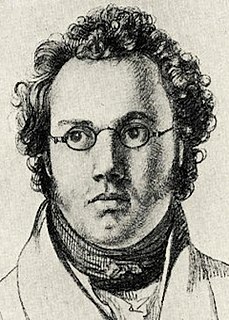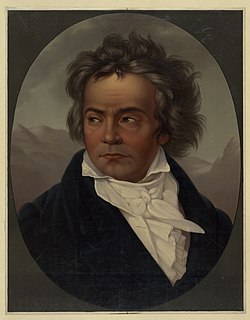Related Research Articles
Sonata form is a musical structure consisting of three main sections: an exposition, a development, and a recapitulation. It has been used widely since the middle of the 18th century.
The Piano Sonata No. 16 in C major, K. 545, by Wolfgang Amadeus Mozart was described by Mozart himself in his own thematic catalogue as "for beginners", and it is sometimes known by the nickname Sonata facile or Sonata semplice.

Eine kleine Nachtmusik, K. 525, is a 1787 composition for a chamber ensemble by Wolfgang Amadeus Mozart. The German title means "a little serenade", though it is often rendered more literally as "a little night music". The work is written for an ensemble of two violins, viola, cello and double bass, but is often performed by string orchestras.

The Trout Quintet (Forellenquintett) is the popular name for the Piano Quintet in A major, D. 667, by Franz Schubert. The piano quintet was composed in 1819, when he was 22 years old; it was not published, however, until 1829, a year after his death.
The Piano Quintet in F minor, Op. 34, by Johannes Brahms was completed during the summer of 1864 and published in 1865. It was dedicated to Her Royal Highness Princess Anna of Hesse. Like most piano quintets composed after Robert Schumann's Piano Quintet (1842), it is written for piano and string quartet.

Ludwig van Beethoven's Piano Sonata No. 29 in B♭ major, Op. 106 is a piano sonata that is widely viewed as one of the most important works of the composer's third period and among the greatest piano sonatas of all time. Completed in 1818, it is often considered to be Beethoven's most technically challenging piano composition and one of the most demanding solo works in the classical piano repertoire. The first documented public performance was in 1836 by Franz Liszt in the Salle Erard in Paris.
In music, the three-key exposition is a particular kind of exposition used in sonata form.

Schubert's Symphony No. 10 in D major, D 936A, is an unfinished work that survives in a piano sketch. Written during the last weeks of the composer's short life, it was only properly identified in the 1970s. It has been orchestrated by Brian Newbould in a completion that has subsequently been performed, published and recorded.
The Piano Sonata in A minor D.845 (Op.42) by Franz Schubert is a sonata for solo piano. Composed in May 1825 and entitled Premiere Grande Sonata, it is the first of three sonatas published during the composer's lifetime, the others being D.850 and D.894. Conceived as a set, these works were composed during what was reportedly a period of relatively good health and spirits for Schubert, and are praised for their quality and ambition. This first sonata in particular marks a significant step toward the composer’s mature piano sonata style; the format and several characteristic stylistic elements continue through the last.
The Piano Sonata in E-flat major D 568 by Franz Schubert is a sonata for solo piano. It is a revision and completion of the Sonata in D-flat major D. 567. The D-flat major version was composed in June 1817, while the E-flat major revision and completion, published in 1829 after Schubert's death as Op. posth. 122, dates from sometime around 1826.
Piano Sonata No. 2, Op. 36, is a piano sonata in B-flat minor composed by Sergei Rachmaninoff in 1913. Rachmaninoff revised it in 1931, with the note, "The new version, revised and reduced by author."
Franz Schubert's Piano Sonata in A minor, D 784, is one of Schubert's major compositions for the piano. Schubert composed the work in February 1823, perhaps as a response to his illness the year before. It was however not published until 1839, eleven years after his death. It was given the opus number 143 and a dedication to Felix Mendelssohn by its publishers. The D 784 sonata, Schubert's last to be in three movements, is seen by many to herald a new era in Schubert's output for the piano, and to be a profound and sometimes almost obsessively tragic work.
The Piano Sonata in A minor, D 537, of Franz Schubert is a sonata for solo piano, composed in March 1817.
Franz Schubert's Piano Sonata in C major, D. 840, nicknamed "Reliquie" upon its first publication in 1861 in the mistaken belief that it had been Schubert's last work, was written in April 1825, whilst the composer was also working on the A minor sonata, D. 845 in tandem. Schubert abandoned the C major sonata, and only the first two movements were fully completed, with the trio section of the third movement also written in full. The minuet section of the third movement is incomplete and contains unusual harmonic changes, which suggests it was there Schubert had become disillusioned and abandoned the movement and later the sonata. The final fourth movement is also incomplete, ending abruptly after 272 measures.
The Piano Sonata in A major D. 664, Op. posth. 120 is a sonata for solo piano composed by Franz Schubert in the summer of 1819.
The Piano Sonata in F-sharp minor D 571, was composed by Franz Schubert in July 1817. The sonata was first published long after the composer's death in 1888 by Breitkopf & Härtel.
The Piano Sonata in E major, D 459, is a work for solo piano, composed by Franz Schubert in August 1816. It was first published in 1843, after the composer's death, by Carl August Klemm in Leipzig, in a publication known as Fünf Klavierstücke.

Franz Schubert's last three piano sonatas, D 958, 959 and 960, are the composer's last major compositions for solo piano. They were written during the last months of his life, between the spring and autumn of 1828, but were not published until about ten years after his death, in 1838–39. Like the rest of Schubert's piano sonatas, they were mostly neglected in the 19th century. By the late 20th century, however, public and critical opinion had changed, and these sonatas are now considered among the most important of the composer's mature masterpieces. They are part of the core piano repertoire, appearing regularly on concert programs and recordings.

Wolfgang Amadeus Mozart's Piano Sonata No. 1 in C major, K. 279 / 189d (1774), is a piano sonata in three movements. It was written down, except for the first part of the opening movement, during the visit Mozart paid to Munich for the production of La finta giardiniera from late 1774 to the beginning of the following March. A typical performance of the sonata takes about 14 minutes. It is the first of his 18 piano sonatas. All but two of the sonatas, No. 8 in A minor and No. 14 in C minor, are in a major key. Also, the first six sonatas seem to follow the cycle of fifths, to the flat side first and then to the sharp side.
Sonatas, duos and fantasies by Franz Schubert include all works for solo piano by Franz Schubert, except separate dances. They also include a number of works for two players: piano four hands, or piano and a string instrument.
References
- Tirimo, Martino. Schubert: The Complete Piano Sonatas. Vienna: Wiener Urtext Edition, 1997.